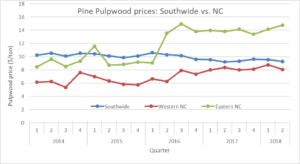Pine Sawtimber and Pulpwood Prices Continued to Improve in Eastern North Carolina
go.ncsu.edu/readext?539495
en Español / em Português
El inglés es el idioma de control de esta página. En la medida en que haya algún conflicto entre la traducción al inglés y la traducción, el inglés prevalece.
Al hacer clic en el enlace de traducción se activa un servicio de traducción gratuito para convertir la página al español. Al igual que con cualquier traducción por Internet, la conversión no es sensible al contexto y puede que no traduzca el texto en su significado original. NC State Extension no garantiza la exactitud del texto traducido. Por favor, tenga en cuenta que algunas aplicaciones y/o servicios pueden no funcionar como se espera cuando se traducen.
Português
Inglês é o idioma de controle desta página. Na medida que haja algum conflito entre o texto original em Inglês e a tradução, o Inglês prevalece.
Ao clicar no link de tradução, um serviço gratuito de tradução será ativado para converter a página para o Português. Como em qualquer tradução pela internet, a conversão não é sensivel ao contexto e pode não ocorrer a tradução para o significado orginal. O serviço de Extensão da Carolina do Norte (NC State Extension) não garante a exatidão do texto traduzido. Por favor, observe que algumas funções ou serviços podem não funcionar como esperado após a tradução.
English
English is the controlling language of this page. To the extent there is any conflict between the English text and the translation, English controls.
Clicking on the translation link activates a free translation service to convert the page to Spanish. As with any Internet translation, the conversion is not context-sensitive and may not translate the text to its original meaning. NC State Extension does not guarantee the accuracy of the translated text. Please note that some applications and/or services may not function as expected when translated.
Collapse ▲After reaching an 11-year high in the last month, U.S. housing starts plunged in June 2018. Privately-owned housing starts in June were at a seasonally adjusted annual rate of 1.17 million units, 12.3% lower than the May estimate and 4.2% below the rate of a year ago. Compared to May 2018, single-family housing starts were down 9.1%, and multi-family starts dropped 19.8% in June 2018.
In the second quarter of 2018, south-wide average stumpage prices followed the downward trend of the U.S. residential construction. South-wide average stumpage prices were down quarter-over-quarter for all pine and hardwood timber products. Dropping stumpage prices in the second quarter is a recent seasonal tendency in the timber markets. On the other hand, both Southern pine and hardwood lumber prices were up in this quarter. The price of Southern pine lumber was $557 per thousand board feet, up 16% from last quarter.

Recent trends in pine pulpwood prices in North Carolina
Pine sawtimber and pulpwood prices continued to climb up in Eastern North Carolina, in contrast to both downward trends in housing starts and south-wide average timber prices, According to TimberMart-South, the average pine sawtimber price was $28.07 per ton, up slightly from last quarter and up 3.5% from the price a year ago. The pine pulpwood price in Eastern North Carolina averaged $14.78 per ton, the second best pulpwood price in the U.S. South, just behind the Eastern Florida pulpwood price. The hardwood sawtimber price also increased slightly to the state-wide average of $24.6 per ton. Both pine Chip-N-Saw and hardwood pulpwood prices in North Carolina, however, dropped in this quarter. For more information on the 2018 second quarter stumpage prices in North Carolina, please visit: Timber Price Data.


